3 Ways to Grow Horse Babies
- On Course Equine Nutrition
- May 25, 2021
- 5 min read
[Gallery of incredible cuteness at the end of this article.]
Tis the season for baby pictures everywhere- horse babies of course- and once they hit the ground it's important to decide how you are going to feed them during the critical young years! There are many components to growing strong, healthy, well-adapted young horses; maximizing movement, providing plenty of socialization, taking care of parasites, and feeding to their growth category.

What do I mean by feeding to their growth category, you may ask? When making nutrition recommendations for horses under the age of 5 years, I first categorize each youngster into one of three growth tracks; slow growth track, moderate growth track, and fast growth track. It's important to make a conscious decision which growth track is appropriate in order to maximize future performance, prevent joint problems, and boost their immune system to prevent disease. Let's discuss these three growth tracks so that you can decide into which category your foal falls.
Category #1: THE FAST TRACK
The fast growth track category is for young horses being produced for intensive, early careers such as Futurity quarter horses, racing thoroughbreds, and future/young event horses. If early performance is in the cards for your young horse, than it's extra important to supply the fuel and nutrients, not only for faster growth, but also to support their immune system during travel and stress, to protect their digestive system against inflammation, to provide the building blocks for bone, tendon and muscle development, and to nourish the brain for early training. It's a tall order! So, these young guns need more; more calories, more vitamins and minerals, and more attention to detail.

Most mare & foal feeds, for all intensive purposes, are designed for fast track growth. The nutritionists behind these formulas have balanced energy, protein, fats, vitamins and minerals to compliment modern horse genetics and their growth potential. Mare & foal feeds can be started before weaning and fed until the horse starts work under saddle. As we all intuitively recognize, there are inherent risks to growing young horses in this way with the additional stress and strain. I have three suggestions to mitigate those risks; 1) read the feeding directions carefully and feed to recommended levels, 2) track your young horse's weight monthly so that you know when and how much to adjust the feed, and 3) consult with a nutritionists if punching the numbers is intimidating.
It takes extra good horse management to grow these babies safely. But when done well and done right, feeding for fast track growth can produce amazing results- seeing a talented young horse reach their peak potential for which they were bred is a special thing!
Category #2: THE MODERATE TRACK
Most horse owners reading this article are breeding mares and raising foals at home for their own pleasure. Chances are that you are not raising foals for the fast track, but rather to be started lightly in their 3 or 4 year old years and then to start serious training after growth plates have closed. You prioritize joint, metabolic, and behavioral health over efficiency of production and you're willing to wait. If you identify with this description, I would put your baby horse in the moderate track group. *I'll explain later why you should NOT be in the slow track group.
Feeding these young horses should be simple, but you are feeding a moving target, and this is where many new to feeding young horses get tripped up. The hard part is that your feeding regime needs to change with your horse's changing body size and activity level. I always suggest weighing your young horse monthly and journaling it along with their body condition score. This can be done with a special weight tape, scales at your local vet hospital, or with equations using body length, height and girth circumference (see below). Tracking the body weight of growing horses over time will take the guesswork out of feeding hay and concentrates to make a total diet plan.
Equations for estimating body weight of weanlings and yearlings
Length is a measurement taken from the point of the shoulder to the point of the buttocks.
in = inches
Weanlings: [heart girth (in)2 × length (in)] ÷ 280 = weight (lb)
Yearlings: [heart girth (in)2 × length (in)] ÷ 301 = weight (lb)
*Accessed from University of Minnesota Extension website.

The best forage base for most breeds in this moderate track category is a moderate calorie grass or alfalfa/grass blend hay. Look for forage tests with a Digestible Energy (DE) of around 1 Mcal/lb, a Relative Feed Value (RFV) between 95-105. If the forage is meeting the caloric needs of the young horse, then a simple ration balancer will perfectly compliment that forage by providing additional amino acids, vitamins, and trace minerals in one simple package. In some situations where forage quality is low, a mix of ration balancer and mare/foal feed may be appropriate. It really does not need to be more complicated than that, but you absolutely want to be absolutely sure that those vitamins and minerals requirements are being met at the very least.
Look for forage tests with a Digestible Energy (DE) of around 1 Mcal/lb, a Relative Feed Value (RFV) between 95-105.
Category #3: THE SLOW TRACK
Aiming for slow growth is not actually recommended- like my old mentor used to say, you can't fool genetics with feed. What he was saying is that the horse is born with a target mature body weight that is based on the combination of genes from their parents. You don't want to mess with that and think that you can under feed to slow that process. Another way to think about "slow track growth" is to use the word "stunted"- I think malnourished. What happens with these malnourished babies is that they end up compensating for that growth when they finally do get adequate nutrition again. That can create just as many problems as over feeding. So, feed your horse babies to their genetic potential by providing all of the necessary nutrition they need to grow STEADY, not slow.
Sign of Good Young Horse Health
No pot bellies! Pot belly is a sign of parasites or poor protein quality.
Not too fleshy! Check that excessive fat pads do not develop over the spine or behind the shoulder.
Healthy skin and coat.
Good appetite.
No joint inflammation.
Consistent and steady growth.
All of this baby talk is making me want to shop for stallions and breed my mare tomorrow! I'm going to have to hold off, however, until we have better facilities to accommodate mare and foal. For now, I'll have to goggle at all of my friend's having horse babies and work on getting my three year old started! Now for the cuteness gallery!




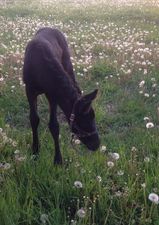
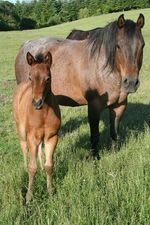
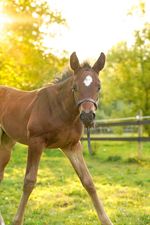
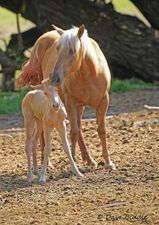
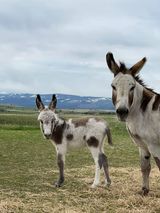
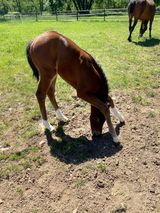
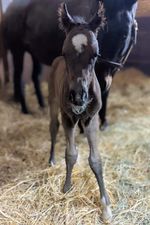
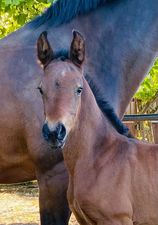

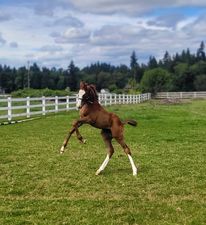

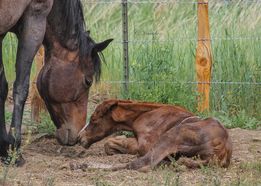


Comments